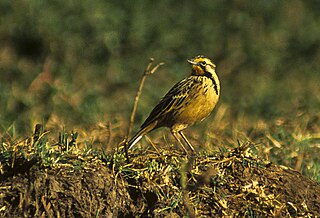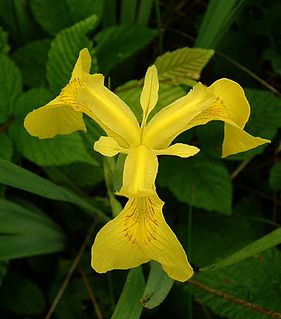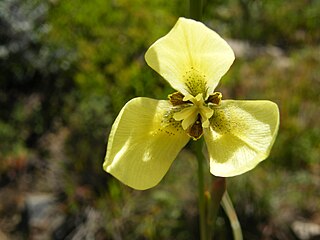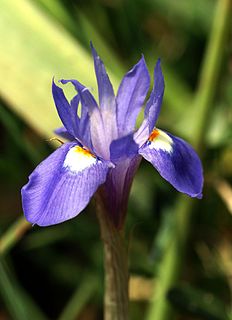
The wagtails, longclaws and pipits are a family, Motacillidae, of small passerine birds with medium to long tails. There are around 65 species in 6 genera. The longclaws are entirely restricted to the Afrotropics, and the wagtails are predominantly found in Europe, Africa and Asia, with two species migrating and breeding in Alaska. The pipits have the most cosmopolitan distribution, being found across mostly in the Old World but occurring also in the Americas and oceanic islands such as New Zealand and the Falklands. Two African species, the yellow-breasted pipit and Sharpe's longclaw, are sometimes placed in a separate seventh genus, Hemimacronyx, which is closely related to the longclaws.

Sharpe's longclaw is a passerine bird in the longclaw family Motacillidae, which also includes the pipits and wagtails. It is endemic to Kenya.

Dietes is a genus of rhizomatous plants of the family Iridaceae, first described as a genus in 1866. Common names include wood iris, fortnight lily, African iris, Japanese iris and butterfly iris, each of which may be used differently in different regions for one or more of the six species within the genus.

Dimorphodon was a genus of medium-sized pterosaur from the early Jurassic Period. It was named by paleontologist Richard Owen in 1859. Dimorphodon means "two-form tooth", derived from the Greek δι meaning "two", μορφη meaning "shape" and οδων meaning "tooth", referring to the fact that it had two distinct types of teeth in its jaws – which is comparatively rare among reptiles.

The yellow-throated longclaw is a species of bird in the family Motacillidae. It is found in Angola, Benin, Burkina Faso, Burundi, Cameroon, Central African Republic, Chad, Republic of the Congo, Democratic Republic of the Congo, Ivory Coast, Gabon, Gambia, Ghana, Guinea, Guinea-Bissau, Kenya, Lesotho, Liberia, Malawi, Mali, Mozambique, Niger, Nigeria, Rwanda, Senegal, Sierra Leone, Somalia, South Africa, South Sudan, Swaziland, Tanzania, Togo, Uganda, Zambia, and Zimbabwe. Its natural habitats are dry savanna, subtropical or tropical seasonally wet or flooded lowland grassland, and sandy shores.

The Abyssinian longclaw is a species of bird in the family Motacillidae.
Fülleborn's longclaw or Fuelleborn's longclaw, is a species of bird in the family Motacillidae. It is found in damp grassy habitats in south-central Africa.

Moraea, the Cape tulips, is a genus of plants in the family Iridaceae, first described as a genus in 1758. The group is widespread across Africa, the Mediterranean, and central and southwestern Asia. The genus name is a tribute to the English botanist Robert More.

The black-headed penduline tit is a species of bird in the family Remizidae. It is found in Central Asia.

Iridoideae is one of the two main subfamilies in the popular family Iridaceae. It contains the best-known genus - Iris. The members of this subfamily are widely distributed worldwide. They grow in all continents except Antarctica.

Moraea bellendenii is a species of plant in genus Moraea that was named after John Bellenden, the English botanist.

Dimorphodontidae is a group of early "rhamphorhynchoid" pterosaurs named after Dimorphodon, that lived in the Late Triassic to Early Jurassic.

Moraea aristata is a species of flowering plant in the family Iridaceae. It is referred to by the common names blue-eyed uintjie or Blouooguintjie in Afrikaans and is a critically endangered species of plant in the genus Moraea, that is endemic to the city of Cape Town and is now restricted to the grounds of the Observatory in the Cape Town suburb of Observatory.

Swartland Shale Renosterveld is a critically endangered vegetation type of the Western Cape, South Africa.

Moraea flaccida commonly known as the one-leaf Cape tulip, is a bulb native to South Africa, including in Fynbos habitats.

Moraea gawleri is a species of plant in the family Iridaceae. It is found in North Cape, South Africa.

Moraea tricolor is a species of plant in the family Iridaceae. It is found in Western Cape, South Africa.

Moraea gigandra is a species of plant in the family Iridaceae. It is found in South Africa.

Moraea sisyrinchium, the Barbary nut, is a species of flowering plant, a dwarf iris, in the genus Moraea, native to southern Europe and the Mediterranean region.

















